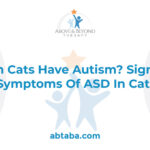Why Do Cats Move Their Tails? Cats move their tails to communicate a range of emotions, from happiness and curiosity to irritation and fear. Understanding these tail movements is essential for cat owners to better connect with their feline friends, interpret their moods, and respond appropriately. At solcat.net, we’re dedicated to helping you understand feline behavior and provide resources to enhance your cat’s life using feline body language and feline communication. Dive into our comprehensive guide to understand your cat better and build a stronger bond.
1. Why Understanding Cat Tail Language Is Important
Understanding cat tail language is essential because it allows you to interpret your cat’s feelings, needs, and intentions accurately, fostering a stronger bond and preventing potential behavioral issues. By recognizing what different tail positions and movements mean, you can better respond to your cat’s emotional state and provide appropriate care and attention.
Decoding your cat’s tail language helps you determine their feelings about particular interactions, allowing you to identify situations that make your cat happy or cause fear. According to Dr. Alison Gerken, a veterinarian specializing in veterinary behavior, reading a cat’s body language, including tail movements, can also help you identify illness and pain more readily. At solcat.net, we want you to use our resources to build a more loving, trusting, and fulfilling relationship with your cat.
2. Decoding Common Cat Tail Movements and What They Mean
Decoding common cat tail movements can reveal a wealth of information about your cat’s emotional state and intentions, helping you respond appropriately to their needs. Here are some of the most common tail positions and movements, along with their meanings:
2.1. Straight Up Tail:
 illustration of a happy cat holding their tail straight up
illustration of a happy cat holding their tail straight up
When a cat’s tail is straight up, they are feeling social and confident, and are approaching in a friendly manner. This indicates a friendly greeting between cats and is how kittens greet their mothers.
According to a 1997 study by the University of Southampton, cats were more willing to approach a cat-shaped silhouette if it had a raised tail. If your cat approaches you with their tail up, they are open to interaction, making it a good time to pet or play with them.
2.2. Question Mark or Hook Tail:
 illustration of a cat
illustration of a cat
When a cat’s tail looks like a question mark—standing upright but curling at the end—it indicates happiness and a friendly approach. This position invites interaction with your cat. While it’s tempting to pet the curly-tipped tail, most cats prefer being petted around their facial glands on their cheeks, under their chin, and next to their ears.
2.3. Low to the Ground Tail:
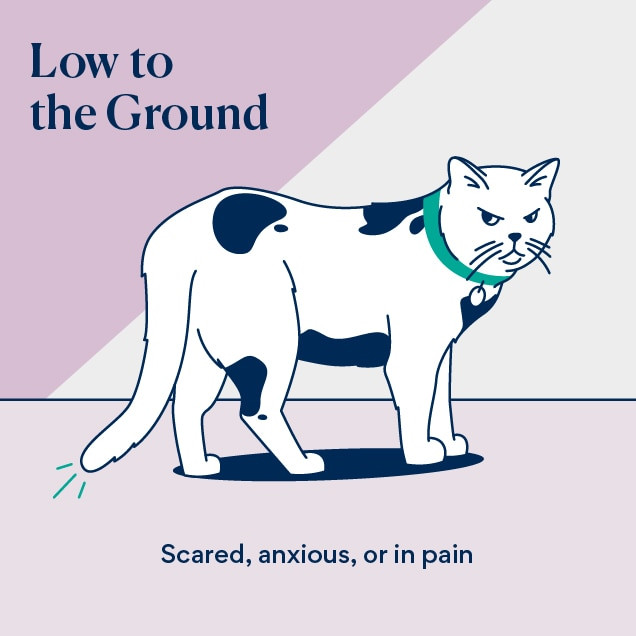 illustration of cat tail language of a tail held low to the ground
illustration of cat tail language of a tail held low to the ground
A cat may lower their tail below the level of their back if they are frightened or anxious. If their tail is tucked between their legs, they are likely very scared or experiencing pain.
According to the American Animal Hospital Association (AAHA), recognizing these signs early can help you address the underlying cause of their distress and provide comfort.
2.4. Puffed Up Tail:
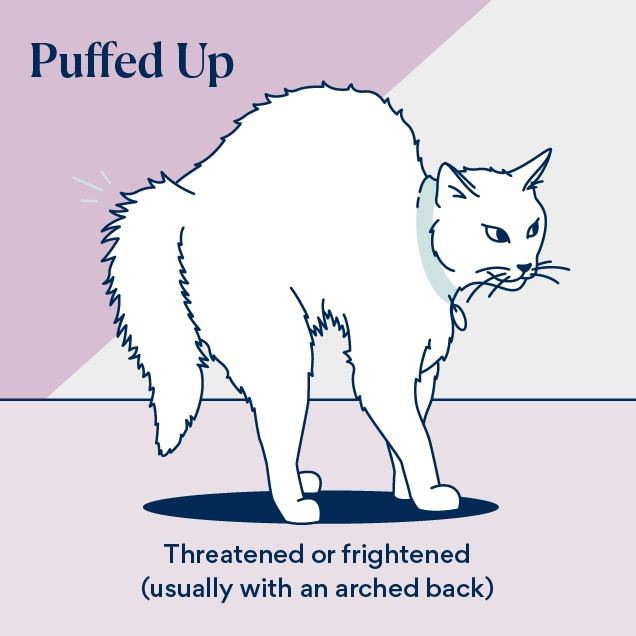 illustration of a cat
illustration of a cat
If your cat assumes the quintessential Halloween-cat posture with a puffed tail and arched back, they are startled or frightened by a sudden, severe threat. Their hair stands on end (piloerection) to appear larger, a defensive reaction indicating they wish to be left alone. This is often triggered by feeling threatened by other animals, approaching dogs, visitors, or sudden noises.
Remove the inciting triggers to decrease your cat’s stress. Interacting with a cat when their hair is standing up may be perceived as a threat, leading to aggression.
2.5. Wrapped Around the Body Tail:
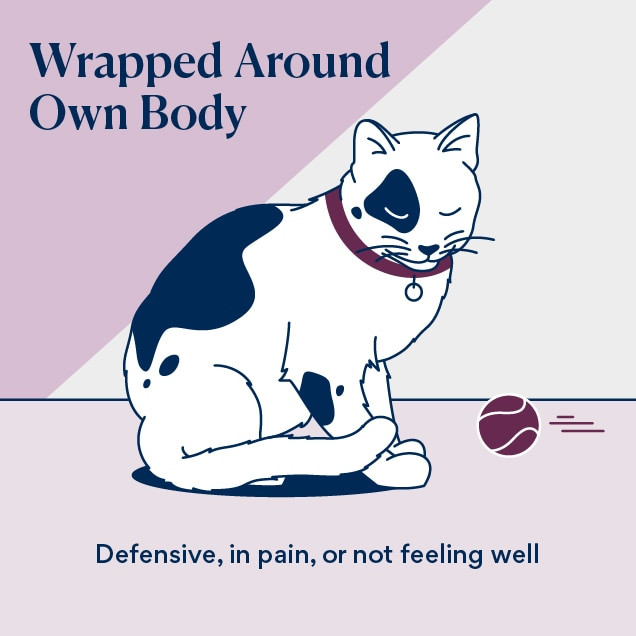 illustration of cat tail language when a cat
illustration of cat tail language when a cat
If your cat is sitting or lying down with their tail wrapped around their body, they are frightened, defensive, in pain, or feeling unwell. When you see this, end your interaction and ensure their environment is free of stressors.
If this posture is frequent and lasts more than a few days, a veterinary evaluation is recommended to rule out pain or illness.
3. Understanding Tail Wagging in Cats
Just like dogs, cats move their tails to express their emotions; however, not all wag-like motions are the same—many convey completely different meanings. Understanding these nuances can significantly improve your ability to interpret your cat’s mood and intentions.
3.1. Thrashing Tail Movements:
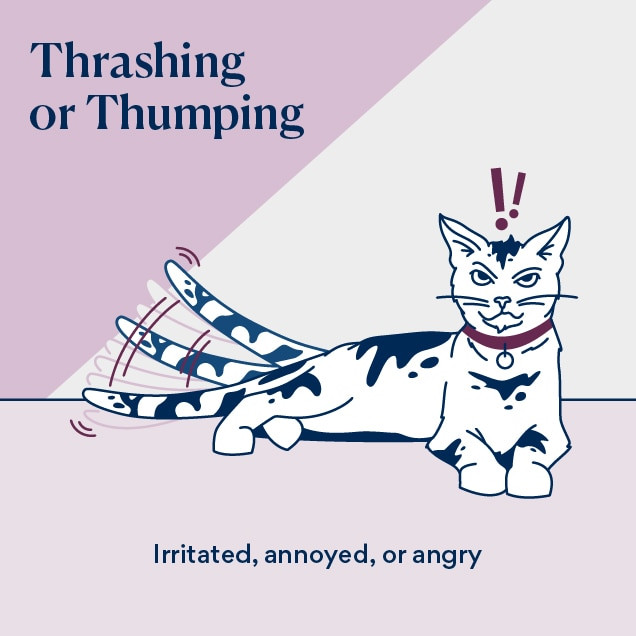 illustration of a cat trashing their tail
illustration of a cat trashing their tail
When your cat thrashes their tail or is thumping it on the ground, they are irritated, annoyed, or angry. This indicates that something is bothering them. This is a distance-increasing behavior.
If you are petting your cat and they start thrashing their tail, they are telling you to stop. Ignoring this signal may lead to hissing, growling, swatting, or biting. Recognizing and respecting these signals helps maintain a positive relationship with your cat.
3.2. Twitching the End of the Tail:
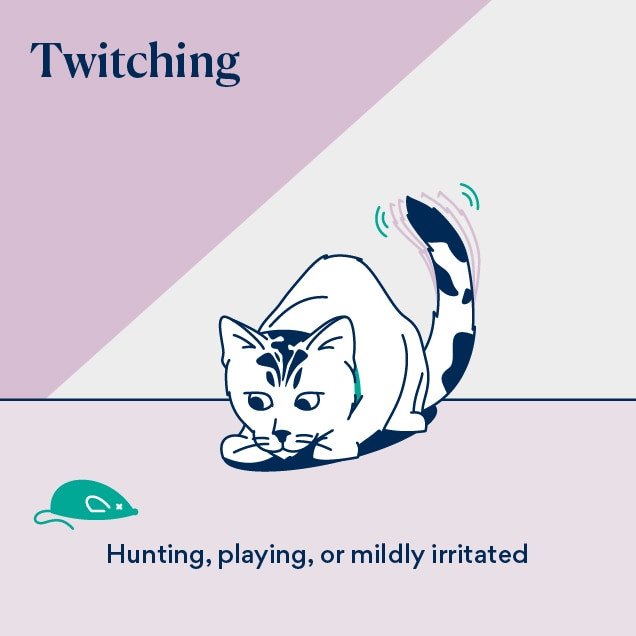 illustration of cat tail language when a cat is twitching their tail
illustration of cat tail language when a cat is twitching their tail
Cats twitch the end of their tails when they are hunting and playing, as well as when they are mildly irritated and frustrated. To understand their mood, observe the context and look for other clues. If they’re not playing or stalking, the twitching likely indicates annoyance.
According to feline behaviorists, paying attention to the situation and other body language cues can provide a clearer understanding of your cat’s emotional state.
3.3. Swishing Tails:
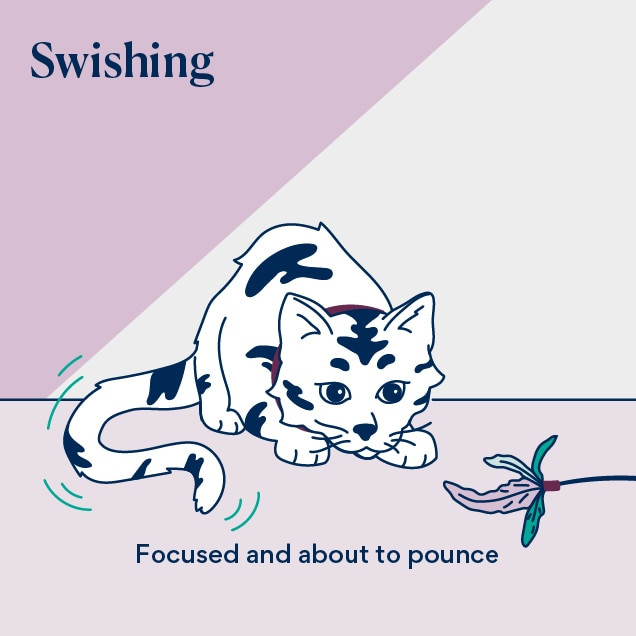 cat tail language illustration of a cat swishing their tail
cat tail language illustration of a cat swishing their tail
When your cat slowly swishes their tail from side to side, they may be intently focused on something like a toy, another animal, or something outside. They might be about to pounce. Engaging in predatory behavior like stalking and pouncing is good enrichment for your cat, so allow them to continue to engage in whatever is captivating their attention.
3.4. Tail Quivers:
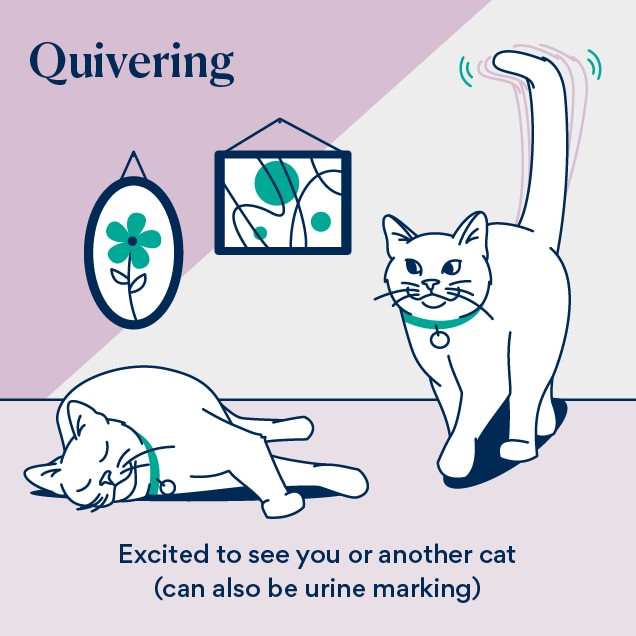 illustration of a cat tail illustration of a quivering tail
illustration of a cat tail illustration of a quivering tail
Your cat may quiver their tail when especially excited to see you or another cat. However, sometimes, when a cat quivers their tail while holding it straight up and backing up against a vertical surface, they may be urine marking. It’s important to note the context and other behaviors to correctly interpret the quivering tail.
4. Affectionate Tail Wrapping
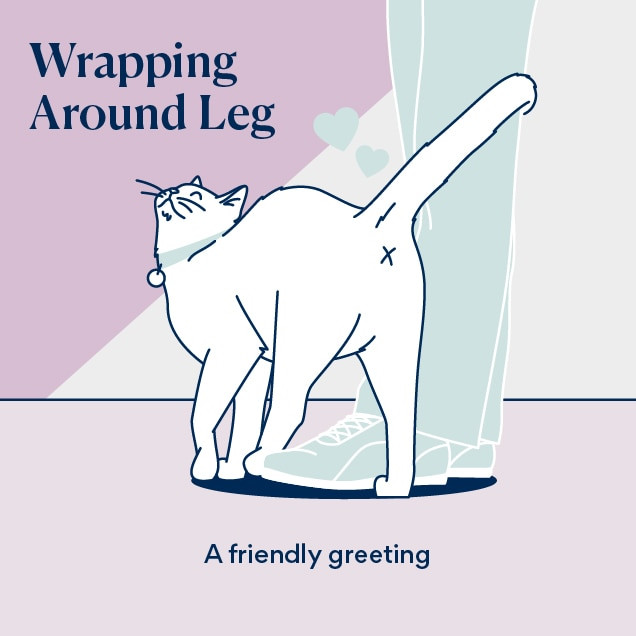 illustration of cat tail language when a cat wraps their tail around human legs
illustration of cat tail language when a cat wraps their tail around human legs
Just as we greet one another with handshakes or hugs, cats may greet by curling their tails around people and intertwining their tails with other cats. Tail wrapping is an affiliative behavior that demonstrates a willingness to interact.
According to research from the Cornell Feline Health Center, tail wrapping is a sign of comfort and trust, indicating a strong bond between the cat and the individual.
5. Integrating Tail Language With Other Body Language Cues
Understanding cat tail language involves considering other body language cues to fully grasp your cat’s emotional state. While the tail is expressive, it’s only one piece of the puzzle.
5.1. Eyes:
A cat’s eyes can indicate their level of comfort and engagement. Dilated pupils may indicate excitement, fear, or playfulness, while constricted pupils can suggest relaxation or aggression. A direct stare can be a challenge, while a soft gaze indicates comfort.
5.2. Ears:
A cat’s ears are highly expressive. Forward-pointing ears indicate alertness and interest, while ears turned to the side or flattened against the head can signal fear, anxiety, or aggression. Twitching ears might indicate mild irritation or focus.
5.3. Body Posture:
A relaxed cat may lie down with their belly exposed, indicating trust and comfort. A tense body posture, with the cat crouched low to the ground, suggests fear or anxiety. An arched back, especially with a puffed-up tail, is a sign of defensiveness or fear.
5.4. Vocalizations:
Cats use a variety of vocalizations to communicate. Purring usually indicates contentment, but can also be a sign of self-soothing when a cat is in pain or distress. Hissing, growling, and yowling are clear indicators of discomfort, fear, or aggression. Meowing is often used to get attention from humans.
5.5. Facial Expressions:
A relaxed cat might have a soft, open mouth and relaxed whiskers. Tense facial muscles, a wrinkled nose, or bared teeth are signs of aggression or discomfort. Slow blinking, often referred to as “cat kisses,” indicates trust and affection.
5.6. Whiskers:
A cat’s whiskers can provide additional insights into their mood. Relaxed whiskers that are pointing forward indicate curiosity and interest. Whiskers pulled back against the face can signal fear or anxiety. Tense, rigid whiskers may indicate aggression or alertness.
6. How Environment Influences Tail Movements
Understanding how the environment influences tail movements is crucial for accurately interpreting your cat’s behavior. A cat’s surroundings can significantly affect their emotional state, leading to specific tail movements that reflect their reactions to the environment.
6.1. New Environments:
In new or unfamiliar environments, cats often exhibit signs of anxiety, such as a low or tucked tail. They may also display a puffed-up tail if they feel threatened by unknown elements in the environment.
6.2. Social Interactions:
The presence of other animals or people can significantly influence a cat’s tail movements. A cat may hold its tail high and quiver it when greeting a familiar cat or human, indicating excitement and friendliness.
6.3. Noises:
Loud or sudden noises can startle cats, leading to defensive tail movements like puffing up or tucking the tail between the legs. Recognizing these reactions can help you create a calmer environment for your cat.
6.4. Territory:
Cats use their tail to communicate territorial claims. A cat may engage in urine marking while quivering its tail, indicating its presence and ownership of the area.
6.5. Changes in Routine:
Even subtle changes in a cat’s daily routine, such as a new feeding time or rearranged furniture, can cause stress. This stress might manifest in tail movements like twitching or thrashing.
7. Medical Conditions Affecting Tail Movements
Certain medical conditions can affect tail movements in cats, making it essential to differentiate between behavioral signals and health issues. If you notice sudden or persistent changes in your cat’s tail behavior, it’s important to consult with a veterinarian to rule out underlying health problems.
7.1. Tail Injuries:
Injuries to the tail, such as fractures, dislocations, or nerve damage, can cause abnormal tail movements or a complete lack of movement. Cats with tail injuries may hold their tail in an unusual position, drag it along the ground, or show signs of pain when the tail is touched.
7.2. Neurological Issues:
Neurological conditions, such as nerve damage or spinal cord problems, can affect a cat’s ability to control their tail movements. These conditions may result in twitching, weakness, or paralysis of the tail.
7.3. Arthritis:
Arthritis in the tail joints can cause pain and stiffness, leading to altered tail movements. Affected cats may be reluctant to move their tail or show signs of discomfort when the tail is touched.
7.4. Skin Conditions:
Skin conditions, such as infections or allergies, can cause irritation and discomfort in the tail area. Cats with skin problems may excessively groom or bite at their tail, leading to changes in tail posture or movement.
7.5. Feline Hyperesthesia Syndrome:
Feline hyperesthesia syndrome is a rare neurological disorder that can cause heightened sensitivity to touch, leading to bizarre behaviors such as tail twitching, biting at the tail, and self-mutilation.
8. Building a Stronger Bond Through Understanding
By understanding your cat’s tail language, you can build a stronger bond with them, enhancing your relationship and improving their overall well-being. Recognizing and responding appropriately to their tail signals can create a more harmonious and trusting connection.
8.1. Improved Communication:
Understanding tail language allows for better communication between you and your cat. By recognizing their emotional state, you can respond in a way that makes them feel understood and secure.
8.2. Reduced Stress:
When you can interpret your cat’s tail signals, you can identify and remove stressors from their environment, reducing anxiety and improving their quality of life.
8.3. Enhanced Trust:
Responding appropriately to your cat’s tail signals helps build trust. They will learn that you understand and respect their needs, leading to a stronger bond.
8.4. Better Playtime:
Understanding tail language can improve playtime. You’ll know when your cat is engaged and enjoying the activity, and when they are becoming overstimulated or annoyed, allowing you to adjust your play accordingly.
8.5. Health Monitoring:
Changes in tail behavior can be an early indicator of health issues. By knowing what is normal for your cat, you can detect potential problems sooner and seek veterinary care.
9. Common Misconceptions About Cat Tail Movements
It’s important to address common misconceptions about cat tail movements to avoid misinterpreting your cat’s behavior. Understanding these misconceptions can help you gain a more accurate understanding of what your cat is trying to communicate.
9.1. Wagging Tail Equals Happiness:
One of the most common misconceptions is that a wagging tail always means a cat is happy, similar to dogs. However, in cats, a wagging or thrashing tail usually indicates irritation or anger.
9.2. Still Tail Means No Emotion:
A still tail doesn’t necessarily mean a cat is feeling nothing. It can indicate a neutral state or focused attention, especially if the cat is observing something intently.
9.3. Puffed-Up Tail Always Means Fear:
While a puffed-up tail often indicates fear, it can also be a sign of excitement or playfulness in certain contexts, especially when combined with other playful behaviors.
9.4. Tucked Tail Always Means Scared:
While a tucked tail usually indicates fear or submission, it can also be a sign of illness or pain. If your cat frequently tucks their tail, a veterinary checkup is warranted to rule out medical issues.
9.5. Ignoring the Tail:
Some people believe that a cat’s tail is unimportant for understanding their mood. However, the tail is a crucial part of a cat’s communication toolkit, providing valuable insights into their emotional state.
10. The Evolving Science of Feline Communication
The science of feline communication is continually evolving, with ongoing research providing new insights into how cats use their bodies, including their tails, to express themselves.
10.1. Recent Studies:
Recent studies have focused on the nuances of cat vocalizations, facial expressions, and body postures. This research helps refine our understanding of how cats communicate with each other and with humans.
10.2. Technological Advances:
Technological advances, such as video analysis and wearable sensors, are being used to study cat behavior in more detail. These tools allow researchers to track subtle movements and physiological changes, providing a more comprehensive understanding of feline communication.
10.3. Expert Opinions:
Veterinarians and feline behaviorists play a crucial role in advancing our knowledge of cat communication. Their clinical experience and insights contribute to a better understanding of the complex ways cats express themselves.
10.4. Resources:
Reliable sources such as the Cornell Feline Health Center and the American Animal Hospital Association (AAHA) offer valuable information on cat behavior and communication.
By staying informed about the latest research and consulting with experts, you can continue to deepen your understanding of your cat and build an even stronger bond.
Understanding why cats move their tails is crucial for interpreting their emotions and intentions. From the friendly upright tail to the irritated thrashing, each movement offers insights into your cat’s world.
At solcat.net, we provide a wealth of information and resources to help you better understand your feline friend. Whether you’re dealing with behavioral issues, seeking tips on cat care, or simply curious about feline communication, we’re here to help. Explore our articles, connect with fellow cat lovers, and discover everything you need to enhance your cat’s life. Visit solcat.net today and unlock a deeper understanding of your beloved companion.
Frequently Asked Questions (FAQs)
1. Why do cats move their tails when they are happy?
Cats move their tails when happy, often holding them straight up with a slight quiver or curve, signaling contentment and a friendly greeting.
2. What does it mean when a cat thumps its tail on the ground?
A cat thumping its tail on the ground usually indicates irritation, annoyance, or anger, signaling that something is bothering them and they want it to stop.
3. Why do cats twitch the end of their tails?
Cats twitch the end of their tails when hunting or playing, or when mildly irritated or frustrated; context and other body language cues help determine the specific emotion.
4. What does it mean when a cat wraps its tail around you?
When a cat wraps its tail around you, it signifies affection, comfort, and trust, similar to a hug, showing they feel safe and connected with you.
5. How can I tell if my cat’s tail movement indicates a medical problem?
If your cat’s tail movement changes suddenly or is accompanied by pain, stiffness, or unusual posture, it could indicate a medical problem like injury or arthritis, warranting a vet visit.
6. What should I do if my cat’s tail is puffed up?
If your cat’s tail is puffed up, remove them from the stressful situation, provide a calm environment, and avoid direct interaction until they calm down, as they feel threatened or scared.
7. Why do cats hold their tails low to the ground?
Cats hold their tails low to the ground when feeling frightened or anxious; a tail tucked between the legs indicates intense fear or possible pain, requiring reassurance and a safe space.
8. How does the environment affect a cat’s tail movements?
The environment significantly affects a cat’s tail movements; new places, loud noises, or the presence of other animals can cause anxiety, fear, or excitement, influencing tail posture and movement.
9. Can I rely solely on tail movements to understand my cat’s mood?
No, you should not rely solely on tail movements to understand your cat’s mood; integrate tail language with other body language cues like eyes, ears, and posture for a complete understanding.
10. Where can I find reliable information about cat behavior and tail movements?
Reliable information about cat behavior and tail movements can be found at reputable sources such as the Cornell Feline Health Center, the American Animal Hospital Association (AAHA), and trusted veterinary websites.

